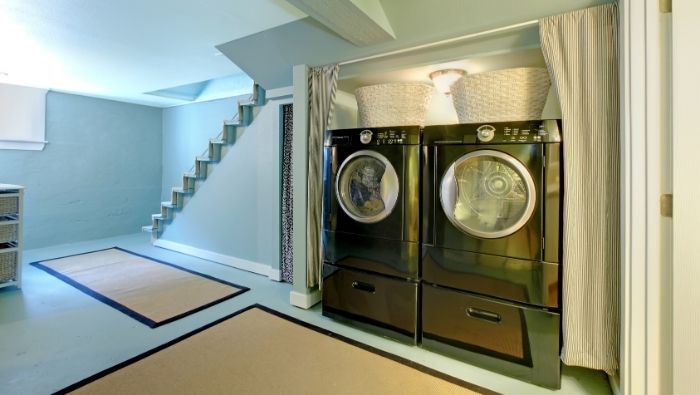Sealing Your Basement From Moisture: Affordable DIY Solutions
A damp basement is a problem that should be fixed sooner rather than later, and one that can be handled by most homeowners. Try these affordable options for sealing your basement and preventing the need for costly repairs.

Basement moisture can be a severe problem.
A damp basement cannot only be musty and depressing, but the moisture can damage any furniture or electronics stored there. Moisture can also lead to mold formation and gradually weaken the home’s foundation.
If you have a basement moisture problem, do not put off repairing it. Consider these affordable DIY options for sealing your basement from moisture.
Causes of Basement Moisture
Standing water, peeling wall paint, rotting wood and rusted appliances are signs that your basement has moisture problems. The two common causes are water seepage and condensation.
Seepage occurs when water passes through the basement walls or floor. Condensation, primarily found on the walls, occurs in cooler basement environments.
A dehumidifier can easily fix a small amount of seepage or condensation. If that doesn’t solve the problem, you must seal the walls and/or floor to prevent seepage.
Sign Up for Savings
Subscribe to get money-saving content by email that can help you stretch your dollars further.
Twice each week, you'll receive articles and tips that can help you free up and keep more of your hard-earned money, even on the tightest of budgets.
We respect your privacy. Unsubscribe at any time.
Inside vs Outside
The decision to waterproof from the inside or the outside depends on the amount of seepage.
Minimal seepage calls for waterproofing from the inside. It’s less expensive than outside waterproofing, so it’s usually your first choice.
Concrete and Silicate Waterproofing
Waterproof coatings and sealers are available for all types of interior walls. Concrete waterproof coating is suitable for unpainted concrete and masonry walls. It must be applied with a heavy brush with bristles made of natural fiber called Tampico.
You can also use silicate-based concrete sealers for unpainted and unsealed walls. After applying two coats of this sealer with a brush or roller, you can paint over it.
Waterproofing Paint
Another inside option is waterproofing paint, similar to regular wall paint. To be effective, it must have a thicker application than ordinary paint. That means you will need at least double the quantity of paint. You can apply waterproofing paint over painted surfaces.
While at the hardware store, get some polyurethane caulk to fill small cracks and gaps before applying the coating or sealer. Check for leaks where the walls meet the floor. A double layer of waterproof coating at this spot is a good idea.
Some cracks and holes are too large to be filled with caulk and paint. Use hydraulic cement to plug those up. Hydraulic cement sets up wet and expands to ensure a good fit. After you’ve filled the crack/hole with hydraulic cement, you can paint.
Exterior Walls
If you choose to waterproof the exterior walls, you’ll need to dig all around the house up to the depth of the foundation walls. Then, use a waterproof coating, much like you would on the interior.
You’ll want to use a membrane and drainage panels in severe cases. The panels must lead to an exterior drain at the bottom of the foundation and divert the water into a storm drain. This work is beyond most do-it-yourselfers and you may want to call in a professional.
Importance of Proper Drainage
Many basement leaks are a result of improper drainage conditions near the house.
Take steps to prevent water from collecting near your foundation. Wherever possible, slope the soil away from the foundation so that any excess water drains away from the house.
Gutter drain spouts should have extensions that direct the water away from the basement walls. You must keep the gutters clean to prevent them from filling up and overflowing near the foundation.
Certain landscaping features can also cause trouble. For example, brick or stone edging around flower beds near the foundation wall can prevent water from draining away.
Sealing Your Basement From Moisture: A DIY Project Most Homeowners Can Do
Being aware of potential leak causes and adopting some prevention measures can help you save significant time and effort in the future. A dry basement is extra space that you can use and will also enhance the value of your home if you ever put it on the market.
Reviewed May 2024
About the Author
Benjamin Roussey is from Sacramento, CA, and grew up doing all varieties of home improvement projects around the home since his parents did not hire contractors or outside help to maintain their home or vehicles. As a result, he has acquired a multitude of home handyman skills in plumbing, carpentry, electrical and everything in between.
Popular Articles
On After50Finances.com
- 9 Things You Need to Do Before You Retire
- You Didn’t Save Enough for Retirement and You’re 55+
- When Empty Nesters Reorganize and Declutter Their Home
- Reinventing Your Career in Your 50s or 60s
- What Mature Homeowners Should Know about Reverse Mortgages
- 2 Reasons to Collect Social Security Benefits As Soon As Possible

